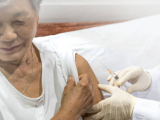Apr 1, 2011
Indonesian woman dies of H5N1 infection
Indonesia's health ministry confirmed that a 28-year-old woman from Yogyakarta province died from H5N1 avian flu, the World Health Organization (WHO) said in a statement today. She started having symptoms Mar 1, was admitted to a healthcare facility on Mar 6, and was transferred to a hospital on Mar 11. She died on Mar 14. Her illness and death push Indonesia's number of H5N1 cases to 176, including 145 fatalities. Yogyakarta is on the south-central coast of Java island. An investigation into the source of her infection revealed that her family owned chicken and ducks and that the woman made daily visits to the local market. Free-roaming poultry were noted in her neighborhood, and chicken deaths were reported there over the past months. So far this year the country has reported five H5N1 cases, four of them fatal. The WHO global H5N1 total now stands at 539 cases and 318 deaths.
Apr 1 WHO statement
Study: Cross-species avian flu transmission varies with subtype
In an experiment involving the use of an imitation barnyard, ducks readily transmitted avian influenza viruses to other bird and animal species, but transmission varied among virus subtypes, according to a report published yesterday by PLoS One. The study was conducted by two researchers from Colorado State University. Because estimating the efficiency of cross-species transmission by epidemiologic methods is difficult, they decided to study the transmission of low-pathogenicity H5 and H7 viruses in "a quasi natural laboratory environment designed to mimic a common barnyard." Mallards recently infected with H5N2 or H7N3 viruses were placed in a room housing other mallards plus chickens, blackbirds, rats, and pigeons, and transmission was assessed by monitoring virus shedding by the ducks and seroconversion in other species over the following 4 weeks. The virus accumulated to high levels in the water pool in each of the two experiments. The H5N2 virus spread from the mallards to other ducks and chickens, but not to rats or blackbirds, whereas the H7N2 virus spread from the ducks to all the other species. The researchers also directly inoculated the non-duck species with the viruses to test the effects; they found that chickens and blackbirds shed significant amounts of virus and developed antibodies, whereas rats and pigeons developed antibodies but in most cases did not shed virus.
Mar 31 PLoS One report
Study finds pandemic vaccine gaps in low-income kids
A study of 2009 H1N1 vaccine uptake among children in a low-income area of New York City found that coverage was low, and most children weren't fully protected during the second pandemic wave that occurred in the fall. The researchers, reporting in Vaccine, used vaccine coverage data from Dec 1, 2009, through Jun 30, 2010, from 19,643 children ages 6 months to 18 years who received care at five community clinics in a primarily Hispanic area. By Dec 1, roughly 2 months after the vaccine was available, only 16.5% had received one dose, and 5.3% were fully covered. At the end of the vaccination period, 36.2% had received at least one dose, and 23.6% had full coverage. Further analysis showed that older age, being a member of a minority group, and having private insurance were linked to lower coverage rates. The researchers suggested that school vaccination may have led to better vaccination rates in elementary school kids and that concerns about vaccine safety may have pushed down uptake in minority populations. They also added that those who had private insurance may have had doubts about whether the 2009 H1N1 vaccine was covered. They concluded that the findings could help shape strategies to improve vaccine coverage in underserved areas in future pandemics.
Mar 31 Vaccine abstract

















